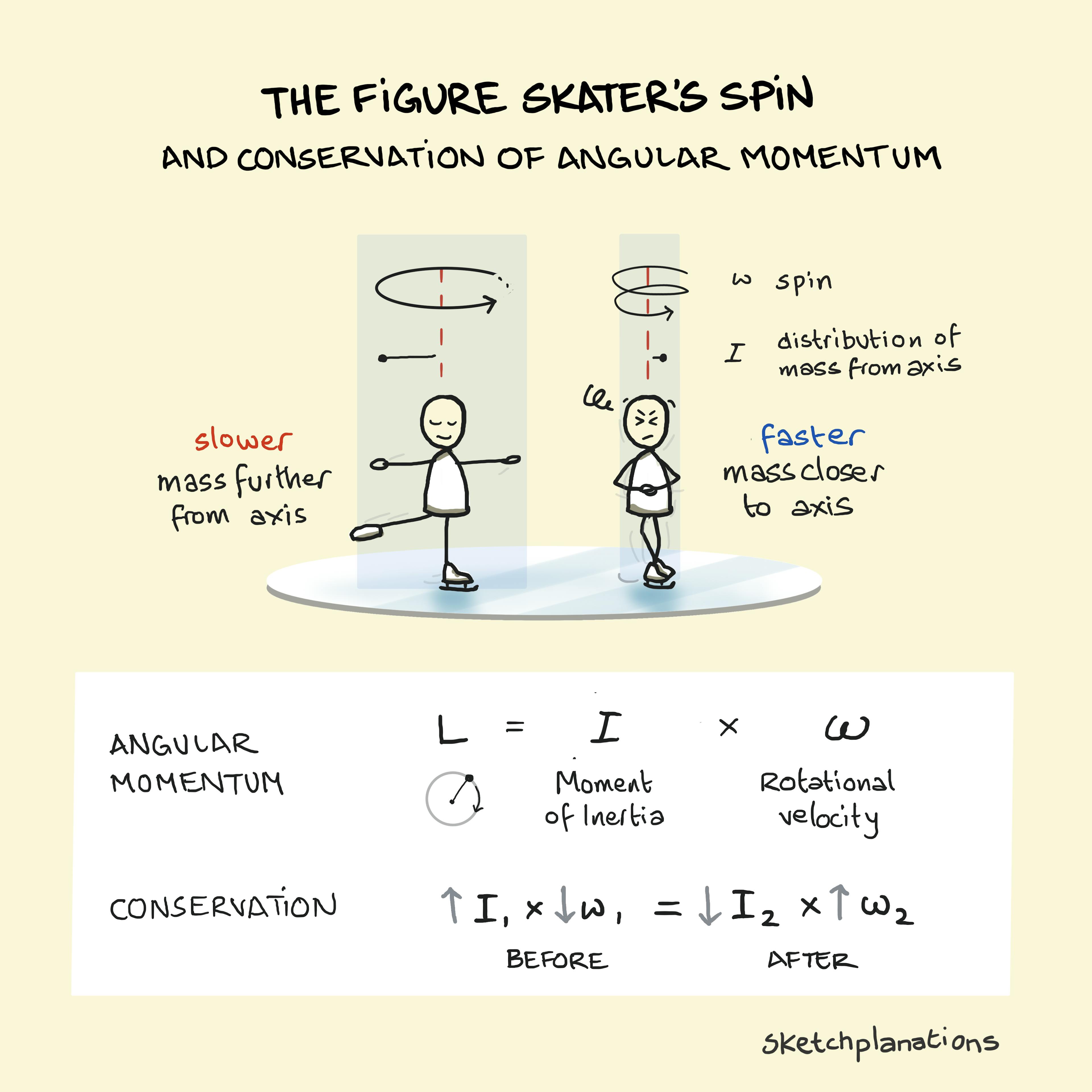The Figure Skater's Spin and the Conservation of Angular Momentum

- Prints
- Copied!
👇 Get new sketches each week
Why figure skaters go slower with their arms outstretched
When a figure skater pulls into one of those incredible spins, they provide one of the clearest examples of the conservation of angular momentum. When they pull their arms in, they go fast, and when they stretch out their arms or legs, they slow down. What's going on?
Angular Momentum
You can think of angular momentum as the oomph in a rotating object, like a weight on a string. It's the rotating equivalent of linear momentum. A system's angular momentum depends on the distribution of mass around the axis of rotation, known as its moment of inertia, multiplied by its velocity of rotation. This is written as:
L = I x ω
Angular momentum L is the product of moment of inertia I and angular velocity ω.
If you swing a weight on a short string versus a long string at the same spin rate, the one on the long string carries more angular momentum. That’s because its mass is further from the axis, giving it a bigger moment of inertia.
Devices like flywheels store energy by setting a large mass spinning. The faster it spins and the heavier it is, the more rotational energy it stores. I think we know this intuitively because when we see a large thing spinning, it looks dangerous.
The Conservation of Angular Momentum
The conservation of angular momentum is a fundamental principle in physics that states that if no external torque (rotational force) acts on a system, then the total angular momentum of that system stays constant.
In the figure skater's case, this means that when they spin with their arms in and their arms out, their angular momentum—their distribution of mass from the axis of rotation x rotational velocity—remains constant.
Arms out
With arms out, mass is further from the axis, so rotation slows.
Arms in
With arms in, mass is closer to the axis, so rotation speeds up.
Examples of Angular Momentum
We can see this at work in other places as well. The first three are pretty easy to test yourself, as I have done.
The Swivel Chair
An easy and fun place to test this is with a swivel office chair. If your office chair spins relatively friction-free, then if you set yourself spinning—or have someone else do it—you'll find that you can change your speed by extending or retracting your legs. Tuck them in and you'll go faster; stick them out and you'll slow down. You can also hold something heavy in your hands and stick your arms out.
Roundabouts
Set a roundabout spinning. If you move towards the centre, it will spin faster than if you move your weight to the edge. You can watch amusing demonstrations by scientists who hate roundabouts . Playgrounds tend to have other spinny-hell devices, so there may be others you can test with.
Swing a Yo-Yo
After making sure that you're not near anyone, you can set a yo-yo or other object swinging around you and pull the string to shorten it. You should find the speed increases just like for the figure skater, as its angular momentum is conserved.
High Divers
Divers that jump from high platforms spin faster when they tuck their legs and arms into their body and slower when they come out of the tuck.
Planets and satellites
A satellite, or planet, travelling in an elliptical orbit will tend to speed up as it comes closer to the body it's orbiting and slow down further away.
Related Ideas to the Conservation of Angular Momentum
Also see:
- The Square Cube Law—why adults are no good at the monkey bars
- Orbit
- The Doppler Effect
- Super Moon — perigee, apogee
- Buoyancy
- Sonic Boom
Learn More
Physics teachers like to demo this by holding weights on spinning office chairs, for which there are lots of videos. I thought the video of a spinning Hoberman sphere (contracting/expanding sphere) was a lovely, clear example.
As an example of iterating on sketches, I produced both a more complex and simpler version of this one.

